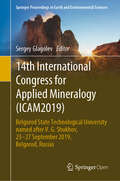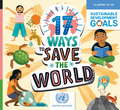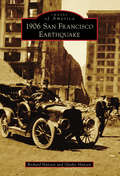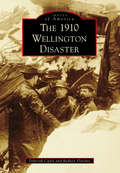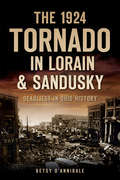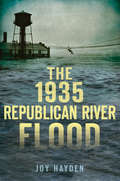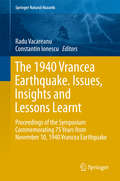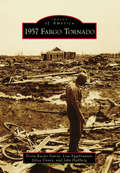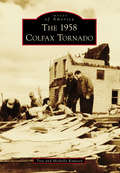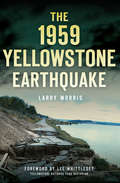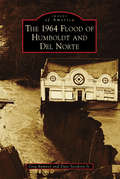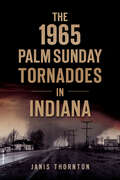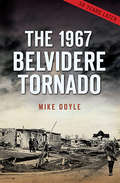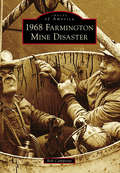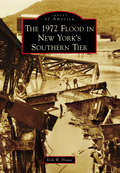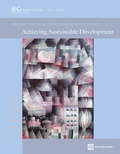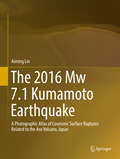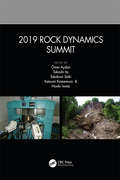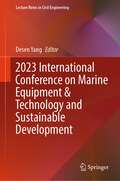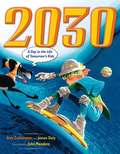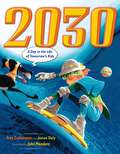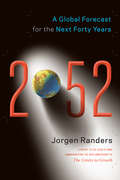- Table View
- List View
1491: The Americas Before Columbus
by Charles MannIn this groundbreaking work of science, history, and archaeology, Charles C. Mann radically alters our understanding of the Americas before the arrival of Columbus in 1492. Contrary to what so many Americans learn in school, the pre-Columbian Indians were not sparsely settled in a pristine wilderness; rather, there were huge numbers of Indians who actively molded and influenced the land around them. The astonishing Aztec capital of Tenochtitlan had running water and immaculately clean streets, and was larger than any contemporary European city. Mexican cultures created corn in a specialized breeding process that it has been called man's first feat of genetic engineering. Indeed, Indians were not living lightly on the land but were landscaping and manipulating their world in ways that we are only now beginning to understand. Challenging and surprising, this is a transformative new look at a rich and fascinating world we only thought we knew.
14th International Congress for Applied Mineralogy: Belgorod State Technological University named after V. G. Shukhov, 23–27 September 2019, Belgorod, Russia (Springer Proceedings in Earth and Environmental Sciences)
by Sergey GlagolevThis open access proceedings of the 14th International Council for Applied Mineralogy Congress (ICAM) in Belgorod, Russia cover a wide range of topics including applied mineralogy, advanced and construction materials, ore and industrial minerals, mineral exploration, cultural heritage, etc. It includes contributions to geometallurgy, industrial minerals, oil and gas reservoirs as well as stone artifacts and their preservation. The International Congress on Applied Mineralogy strengthens the relation between the research on applied mineralogy and the industry.
150 Survival Secrets: Advice on Survival Kits, Extreme Weather, Rapid Evacuation, Food Storage, Active Shooters, First Aid, and More
by James C. JonesAs the world gets more dangerous, you have to be prepared for anything, even the worst. In 150 Survival Secrets, seasoned survivalist James C. Jones provides insider tips to help you and your family survive any catastrophe. Divided into practical sections, 150 Survival Secrets answers every question you’ve ever had about disaster preparedness. One section lists the practical details of making it through any kind of emergency situation. Some topics include: How to survive extreme winter conditionsHow to put together a homemade survival kit in the case of an emergencyHow to safely evacuate from an urban area during a disasterHow much and what type of food to store at home for long-term emergenciesHow to survive an active shooter situationHow to treat common injuries. Other sections answer everything you’ve ever wondered about disaster prepping, including what being a survivalist entails, how to equip your home for survival situations, what gear is essential for a survivalist to own, what elements are essential in a good emergency plan, what types of disasters you can expect to face in your lifetime, and more. So what are you waiting for? With 150 Survival Secrets, you’ll be prepared for anything and everything.
17 Ways to Save the World
by Louise SpilsburyHelp the United Nations to save the world! On 25 September 2015, world leaders at the UN adopted 17 Sustainable Development Goals. These new Goals, which universally apply to all people, are a call to take action to end all forms of poverty, fight inequalities and tackle climate change, while ensuring no one is left behind. For the Goals to be reached, it is not just the actions of governments and businesses that are important - you can help the UN save the world, too! Produced in support of the United Nations, 17 Ways to Save the World is an accessible guide to how you can help the UN achieve their 17 Sustainable Development Goals. As well as charting the global issues identified in the Goals, this book will demonstrate how small lifestyle changes can help in solving the world's biggest issues, empowering you to actively pursue a more sustainable future. This book is the perfect tool for kids aged 9+ looking to make a meaningful difference. Immersive artwork and sensitive text presents serious, worldwide problems in an compassionate manner, encouraging both empathy and action.
1906 San Francisco Earthquake (Images of America)
by Richard Hansen Gladys HansenOne of the greatest disasters of the twentieth century, in words and photos. The Great Earthquake and Fire of 1906 was an unparalleled catastrophe in the history of San Francisco. More than 4.5 square miles of the city burned and crumbled into a windswept desert of desolation. This book is filled with remarkable images, from before the earthquake through the blaze and into the rebuilding. With stories from survivors, and extensive photographs of sites from the waterfront in the east to Golden Gate Park in the west, the marina in the north to the Mission District in the south, readers can gain a vivid sense of this major historical event and how it affected one of America&’s greatest cities.
The 1910 Wellington Disaster (Images of America)
by Deborah Cuyle Rodney FletcherThe town of Wellington was located by the Stevens Pass summit in the Cascade Mountains. During the last days of February in 1910, the snow was relentless in the Cascades, falling as much as one foot per hour and rising up to 20 feet deep in areas. Rotary plows could not keep the lines open as snow covered the railroad tracks almost immediately after being cleared. The Seattle Express, coming from Spokane, and a fast mail train were stranded just beyond the "safety" of the Cascade Tunnel, where they remained unmovable for almost a week under the snowpacked mountains. On March 1, an avalanche swept away the tracks and passengers aboard the two trains as well as several of Wellington's buildings and homes. Almost 100 individuals were killed in just a few seconds, creating America's deadliest avalanche and train disaster in history. Today, the site is part of the Iron Goat Trail off Highway 2, east of Skykomish. The snowshed, the abandoned original Cascade Tunnel, and various scraps of the trains left in the ravine are the only evidence that remain of Wellington, its long-forgotten inhabitants, or the disaster.
The 1924 Tornado in Lorain & Sandusky: Deadliest In Ohio History (Disaster)
by Betsy D'AnnibaleJune 28, 1924, dawned hot and sunny, with fluffy white clouds hovering over a blue and inviting Lake Erie. For two Ohio communities, Lorain and Sandusky, the day ended in unimaginable disaster. In the late afternoon, the blue sky turned dark, and the wispy white puffs morphed into a mass of black thunderclouds as a monster formed on the lake. An F4 tornado, unexpected and not understood, was born from a thunderstorm on the now turbulent waters of Lake Erie. It charged ashore, smashing into Sandusky, retreated again to the lake and then headed east before turning abruptly south to make landfall in Lorain. Before the massive funnel lifted, it would destroy a city, create death records still unbroken and change the lives of thousands of people.
The 1935 Republican River Flood (Disaster)
by Joy HaydenOn May 31, 1935, a storm system surged along the Republican River, bursting its banks in a matter of minutes with a roar that could be heard miles away. The greatest flood to hit the tri-state area of Colorado, Kansas and Nebraska, it left behind a landscape rearranged beyond recognition and claimed more than one hundred casualties. However, amid all the destruction and sorrow, amazing acts of heroism and unwavering courage were reported throughout the valley. Author Joy Hayden reveals the historic disaster and the steadfast resolve of those who witnessed it.
The 1940 Vrancea Earthquake. Issues, Insights and Lessons Learnt
by Radu Vacareanu Constantin IonescuThese proceedings include most of the available information on this major seismic event and its consequences. With an estimated moment magnitude of 7. 7 and a heavy toll in terms of human and economic losses, it ranks as the largest intermediate-depth earthquake in Europe in the twentieth century. Nevertheless, because of the difficult conditions in the 1940s, the lessons learnt after the Vrancea earthquake were not extensively shared with the international scientific community and thus, this book fills a gap in the literature discussing the knowledge acquired after major disasters. Past experience together with current understanding of the 1940 Vrancea earthquake are presented along with the latest information on Romanian seismicity, seismic hazard and risk assessment, and seismic evaluation and rehabilitation of buildings and structures. Moreover, it includes excerpts from Romanian post-disaster reports and textbooks concerning the earthquake.
1957 Fargo Tornado (Images of America)
by Trista Raezer-Stursa Lisa Eggebraaten Jylisa Doney John HallbergOn the evening of June 20, 1957, a tornado ripped through Fargo, North Dakota. It caused the deaths of seven children and five adults and left 116 injured. The tornado destroyed 359 buildings and damaged 2,543 more. The nine-mile path of destruction covered over 66 blocks in town, leaving more than 2,000 people homeless and causing approximately $20 million worth of damage. Following the tornado, first responders quickly united to aid those in need, setting up disaster headquarters, finding shelter for over 600 people, and distributing more than 100 tons of clothing and bedding. Dr. Tetsuya Fujita, a meteorologist, studied the Fargo tornado when creating the Fujita scale (F-scale) and later rated it an F5, the most destructive rating. Images of America: 1957 Fargo Tornado, shines a light on the tornado's destruction and the rebuilding of a united and vibrant community.
The 1958 Colfax Tornado (Images of America)
by Troy Knutson Michelle KnutsonJune 4, 1958, was a muggy and breezy day in western Wisconsin. Across central Minnesota, severe weather was brewing. In the early afternoon, the Minnesota storms crossed the border into Wisconsin. As farmers were tending to milking chores and families were wrapping up the workday and sitting down to supper, one of the worst tornadoes in Wisconsin's history touched down. At 7:07 p.m., what had been multiple, smaller tornadoes combined into one massive F5 tornado that ripped through the village of Colfax, leaving a path of death and destruction that would require months of recovery. In Colfax, 12 people were killed, hundreds were injured, and millions of dollars in damage was done to property. However, in the wake of the storm, a community and its neighbors came together as one to care for the survivors and begin the process of healing and rebuilding.
The 1959 Yellowstone Earthquake (Disaster Ser.)
by Larry MorrisExperience the epic earthquake that shook up Yellowstone and the rescue effort that ensued.At 11:37 p.m. on August 17, 1959, a magnitude 7.5 earthquake rocked Montana's Yellowstone country. In an instant, an entire mountainside fractured and thundered down onto the sites of unsuspecting campers. The mammoth avalanche generated hurricane-force winds ahead of it that ripped clothing from backs and heaved tidal waves in both directions of the Madison River Canyon. More than two hundred vacationers trapped in the canyon feared the dam upstream would burst. As debris and flooding overwhelmed the river, injured victims frantically searched the darkness for friends and family. Acclaimed historian Larry Morris tells the gripping minute-by-minute saga of the survivors who endured the interminable night, the first responders who risked their lives and the families who waited days and weeks for word of their missing loved ones.
1964 Flood of Humboldt and Del Norte, The
by Greg Rumney Dave Stockton Jr.The 1964 flood in the Eel and Klamath Rivers drainages represents an extreme weather event. Both the Northern California and Southern Oregon coasts are host to many floods, but the 1964 flood stands out as a representation of the "perfect storm." Three events occurred that led to the flood. First, a cold front moved in and dropped several feet of snow. Second, a warm front called the "pineapple connection" moved in and released lots of rain while melting the snowfall--local measurements varied from 20 to 32 inches of rainwater in three days. And third, the highest tide of the year had backed up debris and water for several miles. At its peak, the Eel River was discharging more than 800,000 cubic feet per second. Another contributing factor was that besides being one of the fastest rising and falling rivers in the world, the Eel River has the heaviest sediment load second only to the Yellow River in China.
The 1965 Palm Sunday Tornadoes in Indiana (Disaster)
by Janis ThorntonAuthor Janis Thornton reveals the stories of a day in Indiana like no other.Palm Sunday 1965 started as the nicest day of the year, the kind of weather that encouraged Hoosiers to get out in the sun, fire up the grill, hit the golf course, or roll down their car windows and take a leisurely drive. That evening, however, throughout northern and central Indiana, the sky turned an ominous black, and storms moved in, quickly manifesting as Indiana's worst tornado outbreak. Within three hours, twisters, some a half-mile wide, ripped through seventeen counties, devastating communities and leaving death and destruction in their wake. When the tornadoes were finished with Indiana, 137 people were dead, hundreds were injured, and thousands more were forever changed.
1967 Belvidere Tornado, The: A 40-year Anniversary Perspective (Disaster)
by Mike DoyleClaiming the lives of seven adults and seventeen children, the Belvidere tornado struck the most vulnerable at the worst possible time: just as school let out. More than five hundred people suffered injuries. New interviews and fascinating archival history underscore the horrific drama, as well as the split-second decisions of victims and survivors that saved their families and neighbors. Since the tragedy, three more devastating tornadoes have further defined Boone County’s resilience: Poplar Grove in 2008, Caledonia in 2010 and Fairdale in 2015.
1968 Farmington Mine Disaster (Images of America)
by Bob CampioneCoal in the United States was discovered in the 18th century by landowners and farmers on the slopes of the hillsides in the Appalachian region. It was not until the late 19th century that this black rock would become a part of an industrial revolution. One of the first mines to commercially produce coal was in Fairmont, West Virginia, and began the Consolidated Coal Corporation. On November 20, 1968, the Farmington No. 9 mine explosion changed the course of safety for future mining and the lives of 78 families whose sons, husbands, fathers, and loved ones never came back from the cateye shift the next day.
1972 Flood in New York's Southern Tier, The (Images of America)
by Kirk W. HouseIn June 1972, Hurricane Agnes hit the East Coast with a monstrous and devastating force, bringing a deluge across multiple states and slamming four counties in the Southern Tier: Steuben, Chemung, Tioga, and Broome. Dozens died and property damage ran into the millions as Corning, Elmira, Owego, Binghamton, and other communities suddenly found themselves under water. The flood destroyed the Erie Lackawanna Railroad, staggered the Penn Central, shut down Corning Glass Works for weeks, and devastated the Corning Museum of Glass--a major cultural resource. Lives and landscapes were forever changed when homes and businesses washed away in a matter of minutes. Henceforth, the region's history became permanently divided into the times before and the times after the 1972 flood. Through stunning images, The 1972 Flood in New York's Southern Tier chronicles the extraordinary destruction of twisted rail lines, devastated streets, exhausted recovery workers, rivers bursting their banks, cars on houses, and houses on cars, all while capturing the communities' rebuilding efforts and recovery of the glass museum treasures.
2009 Annual Review of Development Effectiveness
by World Bank'The Annual Review of Development Effectiveness 2009' presents evidence on the World Bank's efforts in two areas. Part I tracks the outcomes of Bank projects and country programs and the evolution of monitoring and evaluation (M and E). Part II examines the Bank's support for environmentally sustainable development compatible with economic growth and poverty reduction. The Bank's project performance rebounded in 2008, allaying concerns about the weakened performance in 2007. As previous ARDEs have shown, project performance has been improving gradually for 15 years according to the traditional measure-percent of projects with satisfactory (versus unsatisfactory) outcomes. But IEG ratings of M and E quality for completed projects indicate considerable room for progress. Information to assess impacts continues to be lacking although preliminary data suggests improvements in baseline data collection. Bank support for the environment has recovered since 2002 due to new sources of concessional finance. The outcomes of environment projects have improved in recent years. A growing number of regional projects are addressing the shared use of water resources. New global partnerships are deepening the Bank's involvement in climate change issues. But M and E remains weak: three-quarters of environment-related projects-those managed by sectors other than environment-lack reporting of environmental outcomes.
The 2016 Mw 7.1 Kumamoto Earthquake
by Aiming LinThis book shows the deformation characteristics of coseismic surface ruptures produced by the 2016 Kumamoto earthquake and the relationship between the Aso volcano and active faults. In particular, the rupturing mechanisms and processes involved in the seismogenic faults related to the crustal structure under the Aso volcano caldera are covered. The book is intended to help bridge the gaps between seismology, seismic disaster prevention, volcanology, seismotectonics, and geology and to encourage further studies of earthquake mechanisms and seismic faulting processes.
2019 International Bamboo Construction Competition: From the Concepts to the Realized Pavilions (Springer Tracts in Civil Engineering)
by Kewei Liu Cristoforo Demartino Zhi Li Qinghui Liu Yan XiaoThis volume builds upon the 2019 International Bamboo Construction Competition (IBCC 2019) from the Concepts to the Realized Pavilions. Several designed projects are described, and particular attention is devoted to the realized prototypes. It also presents the Bamboo Eye, an important example of architecture realized by INBAR for the 2019 Beijing Horticultural Expo. As such, the volume provides an overview of the use of bamboo poles and engineered bamboo products for temporary and normal constructions, and represents a compact review of the applications of bamboo poles and/or engineered bamboo products in the construction industry. This book will be of interest for researchers, architects and structural engineers in field of bamboo constructions.
2019 Rock Dynamics Summit: Proceedings of the 2019 Rock Dynamics Summit (RDS 2019), May 7-11, 2019, Okinawa, Japan
by Ömer Aydan Takashi Ito Takafumi Seiki Katsumi Kamemura Naoki IwataRock dynamics has become one of the most important topics in the field of rock mechanics and rock engineering, and involves a wide variety of topics, from earthquake engineering, blasting, impacts, failure of rock engineering structures as well as the occurrence and prediction of earthquakes, induced seismicity, rock bursts to non-destructive testing and explorations. Rock dynamics has wide applications in civil and infrastructural, resources and energy, geological and environmental engineering, geothermal energy, and earthquake hazard management, and has become one of the most topical areas. 2019 Rock Dynamics Summit contains 8 keynote addresses and 128 regular full papers that were presented at the 2019 Rock Dynamics Summit (2019 RDS, Okinawa, Japan, 7-11 May 2019), a specialized conference jointly organized by the Rock Dynamics Committee of the Japanese Society of Civil Engineers (JSCE-RDC), the Japanese Society for Rock Mechanics (JSRM), and which was supported by the International Society for Rock Mechanics and Rock Engineering (ISRM) and the Turkish National Society for Rock Mechanics (TNSRM). The contributions cover a wide range of topics on the dynamic behavior of rock and rock masses and scientific and engineering applications, and include: - Laboratory tests on Dynamic Responses of Rocks and Rock Masses / Fracturing of Rocks and Associated Strong Motions- Estimation Procedures and Numerical Techniques of Strong Motions Associated with the Rupture of Earth’s Crust and Some Strong Motion- Dynamic Response and Stability of Rock Foundations, Underground Excavations in Rock, Rock Slopes Dynamic Responses and Stability of Stone Masonry Historical Structures and Monuments- Induced Seismicity- Dynamic Simulation of Loading and Excavation- Blasting and machinery induced vibrations- Rockburst, Outburst, Impacts- Nondestructive Testing Using Shock Waves- Case Histories of Failure Phenomenon in Rock Engineering 2019 Rock Dynamics Summit contains the state-of-the-art in rock dynamics, and will be invaluable to professionals and academics interested in the latest advances in new techniques for experiments, analytical and numerical modelling as well as monitoring in dynamics of rocks and rock engineering structures.
2023 International Conference on Marine Equipment & Technology and Sustainable Development (Lecture Notes in Civil Engineering #375)
by Desen YangThis book contains original, peer-reviewed, and selected research papers that were presented at the 2023 International Conference on Marine Equipment & Technology and Sustainable Development, which took place in Beijing, China on April 1st 2023. The papers cover a range of topics, including but not limited to: the vision and goals of building a maritime community with a shared future, marine machinery and transportation, marine ecology, environmental protection and conservation, marine safety, future ships and marine equipment, marine engineering, marine information and technology, maritime policy, and global governance.The papers included in this volume provide the latest findings on methodologies, algorithms, and applications in marine equipment and technology, as well as sustainable development. As a result, this book is an invaluable resource for researchers, engineers, and university students who are interested in these fields.
2030: A Day In The Life Of Tomorrow's Kids
by Amy Zuckerman James DalyGlobal events and new technology change how we live from moment to moment. So, what will our world be like in twenty years? Come take a look as futurists Amy Zuckerman and James Daly examine what a kid?s daily life might be like in the year 2030. Inspired and informed by trends and scientifi c and technological research, 2030 is not only a peek at some cool future gadgets (talking dog collars, cars that drive themselves), but also a thoughtful examination of how our lives might be impacted as we adjust to environmental change.
2030: A Day in the Life of Tomorrow's Kids
by Amy Zuckerman James DalyWinner of the 2012 Grand Canyon Reader Award for a Non-fiction bookGlobal events and new technology change how we live from moment to moment. So, what will our world be like in twenty years? Come take a look as futurists Amy Zuckerman and James Daly examine what a kid?s daily life might be like in the year 2030. Inspired and informed by trends and scientifi c and technological research, 2030 is not only a peek at some cool future gadgets (talking dog collars, cars that drive themselves), but also a thoughtful examination of how our lives might be impacted as we adjust to environmental change.
2052: A Global Forecast for the Next Forty Years
by Jorgen RandersForty years ago,The Limits to Growthstudy addressed the grand question of how humans would adapt to the physical limitations of planet Earth. It predicted that during the first half of the 21st century the ongoing growth in the human ecological footprint would stop-either through catastrophic "overshoot and collapse"-or through well-managed "peak and decline. "So, where are we now? And what does our future look like? In the book2052, Jorgen Randers, one of the co-authors ofLimits to Growth, issues a progress report and makes a forecast for the next forty years. To do this, he asked dozens of experts to weigh in with their best predictions on how our economies, energy supplies, natural resources, climate, food, fisheries, militaries, political divisions, cities, psyches, and more will take shape in the coming decades. He then synthesized those scenarios into a global forecast of life as we will most likely know it in the years ahead. The good news: we will see impressive advances in resource efficiency, and an increasing focus on human well-being rather than on per capita income growth. But this change might not come as we expect. Future growth in population and GDP, for instance, will be constrained in surprising ways-by rapid fertility decline as result of increased urbanization, productivity decline as a result of social unrest, and continuing poverty among the poorest 2 billion world citizens. Runaway global warming, too, is likely. So, how do we prepare for the years ahead? With heart, fact, and wisdom, Randers guides us along a realistic path into the future and discusses what readers can do to ensure a better life for themselves and their children during the increasing turmoil of the next forty years.

